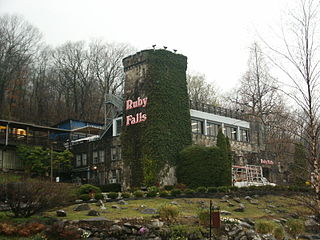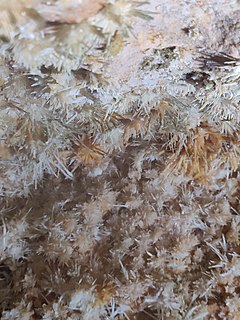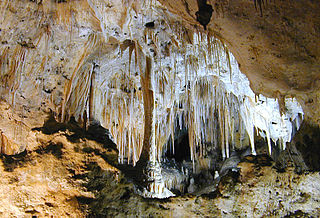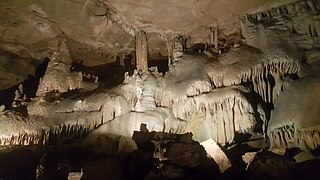Background
Artifacts found in the cave indicate that it was inhabited as long ago as 8000 BC. The earliest tribe known to have used the cave were the Susquehannocks, circa 1600 AD. It was later used by Algonkian (including Lenni Lenape) and Iroquois (probably Mohawk) tribes through the early eighteenth century. Examples of the artifacts are on display in the cave and include arrow and spearheads, tobacco pipes, tomahawks, punches, banner stones, a bone flute, and pottery shards. They also include a rare effigy of the Algonkian guardian spirit, Mesingw.
One room, the "Grotto of the Wah-Wah-Taysee", features a phosphorescent mineral deposit in the ceiling and walls. It was originally thought to be radium, but has since been identified as zinc sulfide reacting with calcite in the limestone. The cave also contains a "musical rock", which resounds with a bell-like tone when struck.
Indian Caverns was known about by European settlers from the late eighteenth century. From about 1816, it was one of several caves used as a hideout by the outlaw David Lewis until his death in 1820. The entrance and grounds were bought in 1928 by Harold Wertz, Sr., a local entrepreneur, and the cave was opened to the public on June 14, 1929. Wertz opened the cave after two years of excavation and about half a million dollars worth of investments. Wertz, along with his family, moved to Florida during the great depression, but returned each summer to run and upkeep the caves. Before the Indian relics were found inside the first few chambers in the caverns, the cave was planned to be called "Franklin Cave", but it seemed more appropriate to be called "Historic Indian Cave". Then in the late 1930s - early 1940s the name was changed to "Indian Caverns". It was a popular destination during the Early Auto Era due to the Edwardian fascination with the "wonders" of nature and remained in continuous operation until 2017. In 2017, the Western Pennsylvania Convervancy purchased the property and is currently in the works of naturalizing the cave (returning it to its original state). The Conservancy plans to use the caverns as a bat sanctuary in the coming years and conduct research on the local bat species.

A cave or cavern is a natural void in the ground, specifically a space large enough for a human to enter. Caves often form by the weathering of rock and often extend deep underground. The word cave can refer to smaller openings such as sea caves, rock shelters, and grottos, that extend a relatively short distance into the rock and they are called exogene caves. Caves which extend further underground than the opening is wide are called endogene caves.

A stalactite (, ; from the Greek 'stalaktos' via stalassein is a mineral formation that hangs from the ceiling of caves, hot springs, or man-made structures such as bridges and mines. Any material that is soluble and that can be deposited as a colloid, or is in suspension, or is capable of being melted, may form a stalactite. Stalactites may be composed of lava, minerals, mud, peat, pitch, sand, sinter, and amberat. A stalactite is not necessarily a speleothem, though speleothems are the most common form of stalactite because of the abundance of limestone caves.

A stalagmite is a type of rock formation that rises from the floor of a cave due to the accumulation of material deposited on the floor from ceiling drippings. Stalagmites are typically composed of calcium carbonate, but may consist of lava, mud, peat, pitch, sand, sinter, and amberat.

The Natural Bridge Caverns are the largest known commercial caverns in the U.S. state of Texas. The name is derived from the 60 ft natural limestone slab bridge that spans the amphitheater setting of the cavern's entrance. The span was left suspended when a sinkhole collapsed below it.

A speleothem is a geological formation by mineral deposits that accumulate over time in natural caves. Speleothems most commonly form in calcareous caves due to carbonate dissolution reactions. They can take a variety of forms, depending on their depositional history and environment. Their chemical composition, gradual growth, and preservation in caves make them useful paleoclimatic proxies.

Russell Cave National Monument is a U.S. National Monument in northeastern Alabama, United States, close to the town of Bridgeport. The monument was established on May 11, 1961, when 310 acres (1.3 km2) of land were donated by the National Geographic Society to the American people. It is now administered and maintained by the National Park Service. The National Monument was listed on the National Register of Historic Places on October 15, 1966.

Luray Caverns, originally called Luray Cave, is a cave just west of Luray, Virginia, United States, which has drawn many visitors since its discovery in 1878. The cavern system is generously adorned with speleothems such as columns, mud flows, stalactites, stalagmites, flowstone, and mirrored pools. The caverns are perhaps best known for the Great Stalacpipe Organ, a lithophone made from solenoid-fired strikers that tap stalactites of various sizes to produce tones similar to those of xylophones, tuning forks, or bells.

At 150.4 miles (242.0 km), Lechuguilla Cave is the eighth-longest explored cave in the world and the second deepest in the continental United States. It is most famous for its unusual geology, rare formations, and pristine condition.

Ruby Falls is a series of underground cascading waterfalls totaling 145 feet (44 m) in Lookout Mountain, near Chattanooga, Tennessee, in the United States.

Anthodites (Greek ἄνθος ánthos, "flower", -ode, adjectival combining form, -ite adjectival suffix) are speleothems (cave formations) composed of long needle-like crystals situated in clusters which radiate outward from a common base. The "needles" may be quill-like or feathery. Most anthodites are made of the mineral aragonite (a variety of calcium carbonate, CaCO3), although some are composed of gypsum (CaSO4·2H2O).

The Wyandotte Caves is a pair of limestone caves located on the Ohio River in Harrison-Crawford State Forest in Crawford County, 5 miles (8 km) north-east of Leavenworth and 12 miles (19 km) from Corydon in southern Indiana which are a popular tourist attraction. Wyandotte Caves were designated a National Natural Landmark in 1972. They are now part of O'Bannon Woods State Park. The cave system is the 5th largest in the state of Indiana.

Carlsbad Caverns National Park is an American national park in the Guadalupe Mountains of southeastern New Mexico. The primary attraction of the park is the show cave Carlsbad Cavern. Visitors to the cave can hike in on their own via the natural entrance or take an elevator from the visitor center.
Honey Creek is a 20.3-mile-long (32.7 km) tributary of Kishacoquillas Creek in Mifflin County, Pennsylvania in the United States.

Raccoon Mountain Caverns is a cave located in Chattanooga, Tennessee in a band of Mississippian Period limestone, part of the Cumberland Plateau.

Germany Valley is a scenic upland valley high in the Allegheny Mountains of eastern West Virginia originally settled by German farmers in the mid-18th century. It is today a part of the Spruce Knob-Seneca Rocks National Recreation Area of the Monongahela National Forest, although much ownership of the Valley remains in private hands.

Indian Echo Caverns is a show cave in Derry Township, Dauphin County near Hummelstown, Pennsylvania, USA. The limestone caves are open for the public to visit via guided tour.
Bluff Dweller's Cave is a show cave located just south of Noel, Missouri that was discovered in 1925 and opened to the public in 1927. The cave was formed in the Pierson Limestone during the Paleozoic Era. The cave's passages total over 4,000 ft in length, with two entrances beneath a limestone outcropping of the bluff.

Cascade Caverns is a historically, geologically, and biologically important limestone solutional cave 3 mi (4.8 km) south of Boerne, Texas, United States, on 226 Cascade Caverns Road, in Kendall County. It has been commercially operated as a show cave and open for public tours since 1932. Informal tours were run as far back as 1875, when Dr. Benjamin Hester owned the cave property. The cave was known by the native Lipan Apache people who lived in the area prior to 1800.
Diamond Caverns in Park City, Kentucky was discovered on July 14, 1859. Tours are available year around; closed Thanksgiving, Christmas Eve, and Christmas. Tours last one hour and is a half mile round trip.

Cave diving is underwater diving in water-filled caves. The equipment used varies depending on the circumstances, and ranges from breath hold to surface supplied, but almost all cave diving is done using scuba equipment, often in specialised configurations with redundancies such as sidemount or backmounted twinset. Recreational cave diving is generally considered to be a type of technical diving due to the lack of a free surface during large parts of the dive, and often involves planned decompression stops. A distinction is made by recreational diver training agencies between cave diving and cavern diving, where cavern diving is deemed to be diving in those parts of a cave where the exit to open water can be seen by natural light. An arbitrary distance limit to the open water surface may also be specified. Despite the risks, water-filled caves attract scuba divers, cavers, and speleologists due to their often unexplored nature, and present divers with a technical diving challenge.















